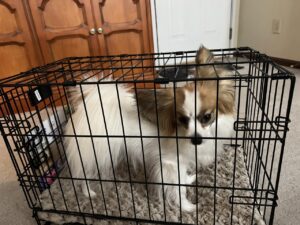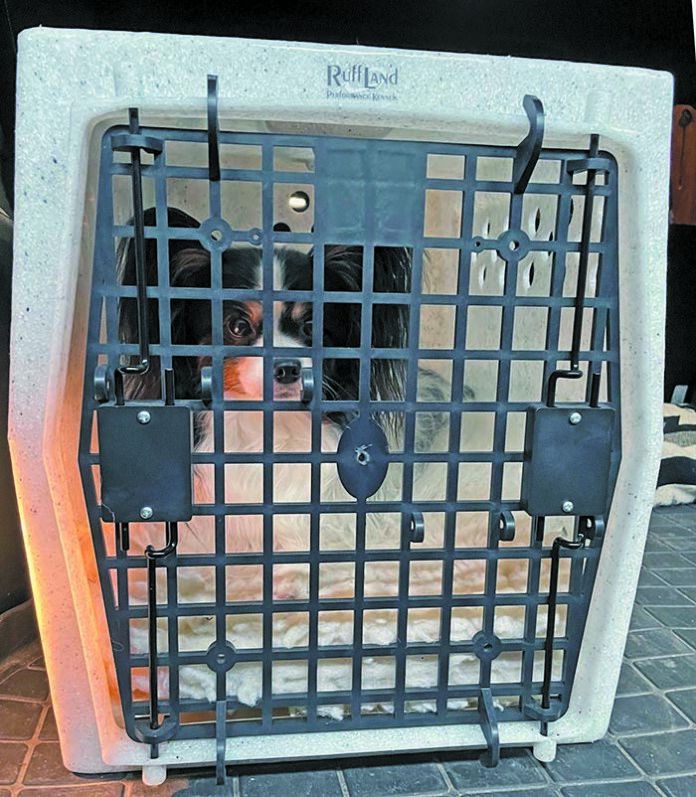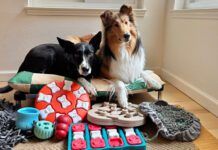A safe dog crate is a sturdy crate that fits your individual dog: his size, his temperament, his training, his environment, and then your needs.
A safe, comfortable crate is big enough for your dog to walk into, sit in, stand in, and turn around. Start by measuring your dog’s standing height, including his ears, and his length, including his tail, then add 2 to 4 inches to both to find the proper size.
Four Main Types of Dog Crates
- Plastic crates: These durable dog crates are made of strong plastic, usually with a swinging, wire door in front and often with a handle on top for moving the crate. Except for the door, plastic crates have smooth surfaces to minimize the chance of an injury. Plastic crates are often not well-ventilated, however. Look for one with holes at least on both long sides. They’re good for travel and easy to clean but bulky and awkward to move, especially if you have a large dog. They’re also not all that pretty.
- Wire crates: Easily cleaned, unrestricted view, well-ventilated. You can purchase heavy-duty wire crates, if needed, but otherwise wire crates are great for all dogs, especially escape artists. Look a crate with two latches on the doors, especially on larger crates. Some wire crates come with a divider for housing more than one dog and/or more than one door for convenience. Wire crates can eventually rust and can become difficult to put together and then unfold, especially if it’s folded and moved around frequently. As the crate becomes worn, watch for stray pieces of wire that have come apart and could cause injury and/or escape.

Wire crates are difficult for a dog to escape from when properly put together, but you still need to be sure all of the dog—including the ear—fits comfortable. In addition, many dogs would prefer a cover over their wire crate. Credit: Cindy Foley - Soft-sided crates: These crates are not the best choice for determined escape artists or dogs who are not properly trained and don’t settle into a crate. It doesn’t take a lot of effort to chew through the canvas or nylon fabric or push through zipper enclosures. These crates can be difficult to clean but are lightweight and portable, as they easily come apart and fold nicely. Soft crates are only suited for dogs who are crate-trained. These crates often come with a top opening that can be used for little dogs. A few brands have more than one door.
- Wooden furniture crates: Wood crates are suited for crate-trained dogs who won’t chew the wood. They are usually house-only crates as they are heavy and don’t easily fold for transportation. These crates can be difficult to clean and tend to be expensive.
Clearly, the plastic and wire crates are the most durable and the most escape-proof. If you’re just training your dog, these are the best choices.
Soft-sided crates are most often selected by competitors and trainers who who take their dogs places and are looking for lightweight, easy-to-fold crates for well crate-trained dogs.
There are also crash-tested travel crates like the Variocage, Impact Crates, SleepyPod (for small dogs), and Ruff Land Kennels that are made to endure a car crash. These come in metal and plastic materials, and many can be custom made to your car space and dog ventilation needs. Some can double as a house or competition crate, but these products tend to be heavy.
Crates Dogs Like
When choosing a crate, give some thought to what your dog likes. Some dogs prefer a wire crate with no covering so he can see everything going on around him. Others seem to feel like they’re on display and aren’t comfortable.
Most dogs like the cave-like feeling naturally offered by a plastic crate or soft-cover crate. Dogs who need a wire crate due to their Houdini-like abilities can get the same cave feeling by purchasing a crate cover or simply placing a cotton sheet or lightweight blanket or throw over the crate. Dogs who bark in wire crates are often quieted by the addition of a cover.
Any crate can have safety issues, depending on your dog. He can get a leg stuck in metal if the crate is not properly put together and sized to the dog; he can chew through wood; and he can pretty easily destroy a soft-sided crate.
Remember that a dog’s crate is a safe, temporary haven for him to eat, relax, or remain confined when necessary. A crate should not be a punishment area or a permanent prison.
All crates need a pad or thick towel on the floor for comfort. Chew-resistant crate beds are available, if you suspect your dog may be destructive. A stuffed Kong toy can keep your dog occupied. If your dog is left in his crate for any length of time, you must provide water as well.
While we believe all dogs should be crate-trained due to the possibility of emergencies, there are dogs that simply won’t relax in a crate. For these dogs, we recommend crate alternatives, as discussed in our article “Creative Confinement: Dog Crate Alternatives.”






